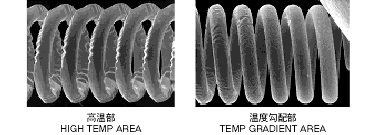![]() > Businesses > Automotive and Industrial Light Source > Miniature Lamps > TECHNICAL INFORMATION
> Businesses > Automotive and Industrial Light Source > Miniature Lamps > TECHNICAL INFORMATION
Businesses
The characteristics (current, brightness) and life vary by voltage. Generally, the relation is formulated as follows.
Since the cold resistance of the filament is one-tenth of the resistance of the filament during lighting, a big transient current at the instant of "switch-on" occurs. This current is called "in-rush current." The maximum current and transient time depends on efficiency of the in-rush current. Below is the current change vs. lighting time. In-rush current can be reduced by applying 85% less of the rated current to the lamp.
INRUSH CURRENT vs. LIGHTING TIME
If the lamp is turned on and off frequently, the lamp life could be reduced due to in-rush current. Since it depends on the conditions of frequency, interval period, lamp size and efficiency, please ask us for suitable specification with the expected application.
After lighting for a long time, the filament becomes weaker and fragile due to growing crystals over time. Filament thickness decreases and lamp life will become shorter due to the ongoing evaporation of the tungsten filament as the temperature rises and current value increases. Sometimes the filament turns could become shorter by deformation of the filament due to vibration and/or mechanical shock. In the case of lighting under DC voltage, this phenomena would be more obvious. For heavy shock and vibration applications, a lamp which has a lower rated voltage and higher current would be selected.
Notching is the phenomena in which a saw-toothed surface appears over portions of the filament. The notching grows due to the electro-migration of tungsten ions and becomes more noticeable after long operation. Notching depends on the lighting condition, either DC or AC. At AC voltage, the notching occurs near the area where the filament is supported by the anchor or is connected with the lead-in wire. These areas have a temperature gradient. At DC voltage, since tungsten ions move in only one direction, the notching occurs over the entire filament. Therefore, the lamp life at DC voltage becomes shorter than at AC voltage because of more severe notching. In order to reduce the notching, a rhenium tungsten filament, which has a higher temperature recrystallization point, can be used.

There is no relationship between the depth of notching and the diameter of filament. This means the influence of notching decreases as filament diameter increases. Therefore, by using a thicker tungsten filament, longer lamp life can be achieved.

When you would like to improve the minimum life of the lamps whose characteristics are affected by Notching phenomenon, we recommend the lamps using rhenium tungsten material which has high recrystallization temperature. Besides, these lamps are effective to improve the resistance against vibration and shock.
Color temperature (K) is correlated with lamp efficiency (lm/W). As is shown in the graph, color temperature increases as efficiency (lm/W) increases. Gas-filled lamps can be of white color because the color temperature is higher at the same efficiency compared with vacuum lamps.
A Lamp makes a filament incandescent at a high temperature. Therefore, surface temperature of a bulb becomes high due to much infrared radiation.